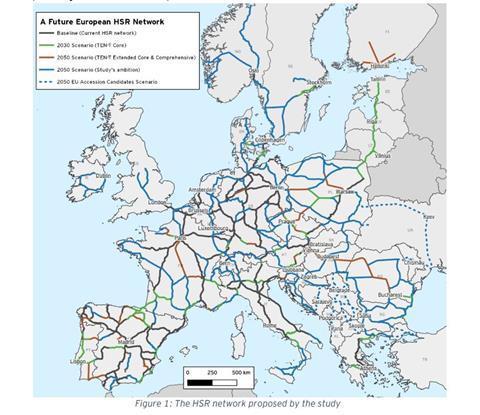
EUROPE: A master plan for massive expansion of the high speed rail network has been proposed by the Europe’s Rail Joint Undertaking in co-operation with the Community of European Railways, supply industry association UNIFE and the AllRail association of new entrants to the passenger market.
Unveiled on January 23, the Smart & Affordable High-Speed Services in the European Union study calls for the European Commission and EU member states to work towards implementation of a high speed network connecting EU capitals and major cities. It suggests that this would require investment totalling €550bn, generating net positive benefits to society worth around €750bn by 2070.
The study assessed three network scenarios, examining the socio-economic and environmental benefits. It says investment in a comprehensive network of high speed lines would deliver added value to society and ‘massively reduce the environmental footprint of European passenger transport’.
The study covers countries with projects in the TEN-T network, EU candidate and potential candidate countries, as well as the existing high speed line from the Channel Tunnel to London and planned high speed routes in the UK.
The proposals would combine investment in new lines with enhancement of existing high speed routes, featuring greater digitalisation and automation using ERTMS.
The study concludes that high speed rail could ‘potentially become the dominating mode in its market’, noting that historical data shows that high speed lines ‘can lead to significant reductions in the demand of air travel’. It suggests that the proposals in the EU’s Smart & Sustainable Mobility Strategy, which calls for a doubling of high speed rail traffic from 2015 levels by 2030 and tripling by 2050, need to be scaled up with more ambitious targets.
The case for more investment can be made by quantifying the benefits of growing high speed rail traffic and comparing it with competing transport modes and proposed new technologies, the study finds. This can be achieved by examining the size of the market for high speed rail in 2030 and 2050 and then assessing the impact in terms of associated costs and benefits of developing the network.
The study draws on various scientific and economic reports on the impact of 10 possible shocks on passenger transport demand designed ‘to simulate the impact of future possible policy measures and investments in new infrastructure and technologies’. Cost-benefit analysis is used to compare the benefits of modal shift with construction costs to obtain a Net Present Value and benefit:cost ratio. Among the benefits forecast in the 2030 scenario is a 1∙5 billion tonne reduction in CO2 emissions, with the 2050 scenario almost tripling this benefit.
A product for the masses
The ambitious scale of the proposals was underlined by AllRail Secretary General Nick Brooks who said ‘we want to see [high speed rail] displace the private individual motor car as a product for the masses, for everyone from the budget conscious to very affluent travellers. High speed rail must form the backbone of speedy door-to-door travel across the EU.’
Brooks also warned that high speed services needed to be frequent, accessible, easy to find and easy to book, with capacity of around 1 000 passengers per train. He also called for ‘aviation to be taxed fairly’, noting that high speed rail could compete against low-cost airlines.
Carlo Borghini, Executive Director of the Europe’s Rail research initiative, pointed out that Europe does not currently have a true high speed network but has ‘a series of islands’.
‘The high speed rail network is not wishful thinking but, together with all the ongoing investments, including in EU rail research and innovation, the answer to reaching COP’s targets for passenger mobility as translated in the European Commission’s Smart & Sustainable Mobility Strategy’, Borghini added.
Alberto Mazzola, Executive Director at CER, said that ‘the positive cost:benefit ratio of the study shows why Europe needs a high speed master plan as a response to the ongoing crisis on energy and sustainable mobility’. He believes the European Commission has been ‘too shy’ and needs to ‘win the minds of ministers’, pointing out that ‘railway investments require a long-term commitment and sufficient funding’. He noted that the TEN-T Regulation, now in the process of revision, should recognise this.
UNIFE Director General Philippe Citroën was confident that the European supply industry would be able to deliver the required trains and equipment for the proposed network and said that the industry ‘looks forward to making this vision a reality’.
The study was prepared for the Europe’s Rail Joint Undertaking by Ernst & Young in co-operation with Università Bocconi and Blue Arches consultancy, using data and information made available by AllRail, CER and UNIFE.
















